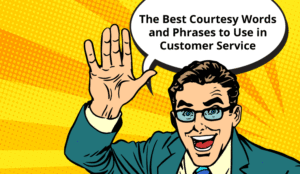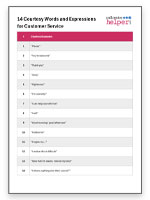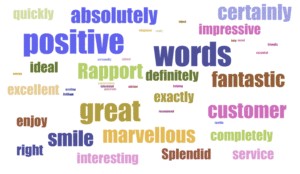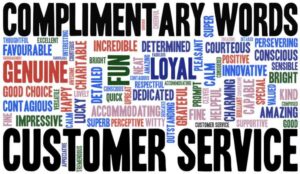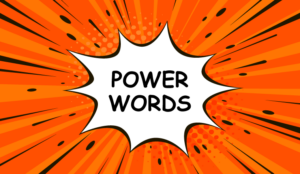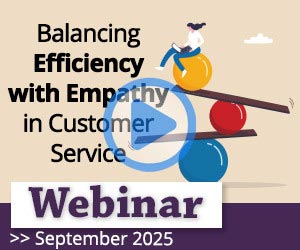A key aspect of building positive customer-advisor relationships is using polite and respectful language.
By incorporating courteous expressions into every interaction, contact centre advisors can foster an environment of mutual respect, ultimately strengthening rapport and enhancing the overall customer experience.
To help you we have put together a quick run-down of the courtesy words that contact centre advisors should have in their vocabulary, along with guidelines on when they should be used.
14 Courtesy Words and Phrases for Customer Service
Lets get started with examples of courtesy words and statements that contact centre agents can use:
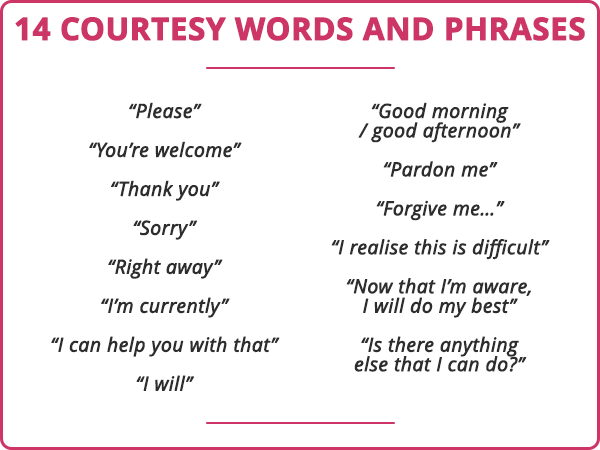
These are the top fourteen courtesy words and expressions (as shown in the image above) that can easily be used in customer service conversations:
- “Please”
- “You’re welcome”
- “Thank you”
- “Sorry”
- “Right away”
- “I’m currently”
- “I can help you with that”
- “I will”
- “Good morning / good afternoon”
- “Pardon me”
- “Forgive me…”
- “I realise this is difficult”
- “Now that I’m aware, I will do my best”
- “Is there anything else that I can do?”
We will explore each of these phrases below, explaining how to use them effectively in customer conversations, and have split them up into:
- Common Courtesy Words
- Words to Provide Reassurance and Immediacy
- Words to Offer a Commitment
- Words to Greet a Customer
- Words to Clarify a Situation
- Words to Acknowledge a Customer
- Words to Close the Call
Common Courtesy Words
Let’s also look at the most common courtesy words, which can be sprinkled into an interaction as a signal of mutual respect.
1. “Please”
Don’t forget to say please when asking for information from the customer! Doing otherwise will seem rude and may damage any rapport than had been built previously.
2. “You’re “Welcome”
When a customer expresses their gratitude, saying “you’re welcome” shows that it has been acknowledged by the advisor. Such acknowledgement statements are a powerful tool in building rapport.
Also, using “you’re” instead “you are” makes the conversation sound more natural, taking away the robotic tone many negatively associate with the contact centre.
3. “Thank You”
When the customer hands over their information or pays the advisor a compliment, it is important to say thank you. Common sense, right?
4. “Sorry”
As a representative of an organisation, it is courteous for an advisor to apologise when something goes wrong.
However, an advisor should not say “we’re sorry”, “I’m sorry” should instead be used, so the customer can feel assured that someone has taken it personally upon themselves to resolve their query.
It is also good to compliment customers, to be more courteous, for advice, read our article: 50 Great Complimentary Words to Use in Customer Service
Words to Provide Reassurance and Immediacy
To assure the customer that their query is a matter of importance, it is vital to provide them with a sense of immediacy.
This is also courteous as the advisor is demonstrating that they understand the value of the customer’s time and that they are doing their bit to speed up the process.
5. “Right Away”
Using this phrase signals that the process of solving the customer query has been enacted. For example:
“I’ll contact the delivery driver right away and give them this new information.”
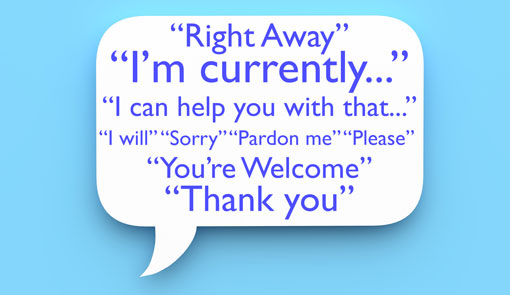
6. “I’m Currently”
If the advisor informs the customer as to what they are doing to help them while still on the phone, they are taking control of the situation.
This is courteous as it allows the customer to feel as if the problem has been “lifted from them”, while it is also a good tactic to minimise “dead air”.
“Dead air” is a period of silence during a customer–advisor interaction, which may damage the rapport-building process.
7. “I Can Help You With That”
Using the phrase “I can help you with that” can be considered to be the magic words for customer service. It gives the customer reassurance that they have reached the correct person in the company to deal with their query.
For more advice on the phrases an agent can use to reassure a customer, read our article: Reassurance Statements in Customer Service – With Examples
Words to Offer a Commitment
During difficult queries, especially those where the customer has high emotional interest, making a commitment over the phone can help to comfort the customer, which not only helps to show courtesy, but also empathy.
8. “I Will”
To make a commitment, “I will” is the obvious place to start. And following up on this promise will help to establish a basis of trust, which should encourage future customer loyalty.
Empathy can make a huge impact when speaking to a customer, for advice on this, read our article: 18 Empathy Statements That Help Improve Customer-Agent Rapport
Words to Greet a Customer
Being courteous in an opening statement is a great way to set the foundation for a strong customer–advisor interaction.
9. “Good Morning / Good Afternoon”
According to our readers, good morning/ good afternoon is the best opening to a contact centre greeting, although “welcome to” and “thank you for calling” were also well received.
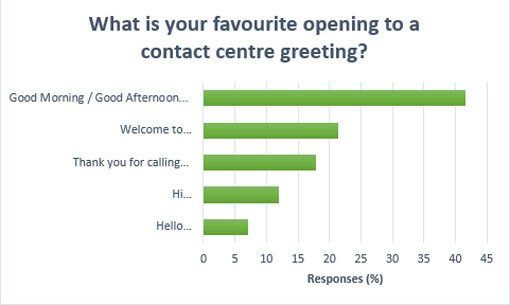
These are polite and welcoming openings to an interaction and a full, courteous greeting should be phrased like the example below:
“Good morning / afternoon! Welcome to [INSERT COMPANY NAME] customer service. My name is [INSERT NAME]. How can I help you?”
#tip it is also courteous for an advisor to introduce themselves in their greeting, so the customer has a good idea of how to address them.
To find out more ways to greet a customer, read our article: The Best Customer Service Greeting Phrases – with Examples
Words to Clarify a Situation
There will be occasions when the customer feels as though they have fully detailed their query yet the advisor cannot quite understand the situation.
In these scenarios, it is important for advisors to use courtesy words like those below, so that the customer does not feel as though the advisor was simply not listening to them.
10. “Pardon Me”
While we earlier encouraged the use of contractions (e.g. “you’re” as an alternative to “you are”) to initiate natural conversation, when clarifying a situation, it is important to use the more formal “pardon me” instead of “what?”
While “what” may be more natural, some people might still consider it rude, especially over the phone, where it is more difficult to convey tone.
11. “Forgive Me…”
“Pardon me” is a good reflex phrase when an advisor has missed a small part of the conversation. However, when large chunks of information have been lost, “forgive me” is more appropriate.
For example, it can be used in this way: “Forgive me, I didn’t catch your email address. Could you please repeat it for me?”
For more advice on how agents can clarify a situation, read our article: 15 Clarifying Questions For Customer Service
Words to Acknowledge a Customer
To build rapport, it is important that the customer feels that their thoughts have been acknowledged.
However, during difficult customer–advisor interactions, where the customer has discussed an emotional situation, it is important to avoid the phrase “I understand”. This is because the customer may take offence at the suggestion that the advisor shares their emotions in some way.
So, the following alternatives can be used to courteously acknowledge the customer:
12. “I Realise This Is Difficult”
This is effective in terms of acknowledging a problem without voicing any personal thoughts on the matter.
13. “Now That I’m Aware, I Will Do My Best”
This can be used for situations that are not necessarily emotional and, with the repeated use of “I” in the statement, it shows that the advisor is courteously taking personal ownership of the matter.
If you are looking for more acknowledgement phrases an agent can use, read our article: The Top 10 Acknowledgement Statements for Customer Service
Words to Close the Call
It’s important to remain courteous for the full duration of the call, so customers feel comfortable in voicing more concerns or queries. This consequently boosts satisfaction.
14. “Is There Anything Else That I Can Do?”
Closing courtesy statements of this nature are important and should ideally be customary.
Instead of using the standard ‘Thank you for your time today’ it is much better use the extended alternative closing, ‘I’m glad that I has able to help [Customer Name], is there anything else I can help you with?’
Using this phrase also helps to highlight to the customer that there are no company time constraints on advisors that would prevent them from providing great customer service.
You may also find it helpful to read our article on The Best Ways to Start and End a Customer Conversation – With Example Phrases
Printable – 14 Courtesy Words and Expressions for Customer Service
Do you want to download this to share with your team?
Get your free download of 14 Courtesy Words and Expressions for Customer Service now:
Expressions to Avoid
Below are some other examples of phrases that should not be used in customer service and a set of courteous expressions that can be used to replace them.
| Avoid | Use |
|---|---|
| It’s company policy | In this situation, I would |
| Can you hold for a moment? | If it’s OK with you, I’m just going to put you on hold while I get your details |
| Thank you for your time today | I’m glad that I was able to help [Customer Name], is there anything else I can help you with? |
| If you check our website | I’ll send you a link to a useful web page, and I can take you through it as well |
| I don’t know | Let me find out for you |
How to Show Courtesy in Client Calls
As well as the language that advisors use, there are habits that advisors can adopt to show courtesy over the phone.
These include:
Use Personal Pronouns
Many of the courtesy words and expressions above included personal pronouns, such as “I” and “you”, which are often encouraged in customer service. These can also be labelled as courtesy words.
For example, the customer will often prefer the advisor to take personal ownership of their situation, signified by using the word “I”, rather than hiding behind the corporate “we”.
In addition, saying “I” and “you” helps to convey interest in the customer as an individual, as the advisor signals to them that they are the priority.
Ask the Customer How They Would Like to Be Addressed
While it may be more courteous to address the caller as “sir” or “ma’am”, using this language can feel systematic, as though the advisor is reading from a script.
So, instead advisors could try asking the customer if they are happy being referred to by their first name. This is equally courteous, while it is less likely to damage rapport than the method mentioned above.
Another option would be to ask the customer directly how they would like to be addressed, which could work to the same effect.
Speak with a Smile and Maintain Good Posture
While the words and expressions specified earlier will help to convey courtesy, it must be remembered that how you say something is just as important as what you say.
It is courteous to sound interested in the matter at hand and smiling can make the advisor sound more upbeat and positive on the phone.
One of our readers, Kevin, agrees, stating: “Indeed it does work, we have done practice sessions where two advisors sit back to back and one of them talks and the other listens.
“Each advisor can normally hear if the agent is smiling, as well as things like posture. It all comes across if someone is grumpy and slouching.”
Use Verbal Nods
In addition to attentive, polite and respectful language, reassuring noises can also be used to show courtesy. These are often known as verbal nods.
When the customer speaks for a long period of time, it could be disconcerting to hear silence on the other end of the phone. So, verbal nods such as saying “yeah” or “uh huh” can help to reassure them.
This is courteous as it avoids the caller feeling helpless and assures them of the advisor’s focus and understanding.
For more great tips on the topic of improving the customer service language used in your contact centre, read our articles:
- Customer Service Language: Changing the Language of Your Contact Centre
- The Best Power Words and Phrases to Use in Customer Service
- Positive Language for Customer Service Conversations
- Courtesy Calls: A Great Way to Enhance CX
Author: Charlie Mitchell
Reviewed by: Robyn Coppell
Published On: 20th Sep 2017 - Last modified: 14th Aug 2025
Read more about - Skills, Charlie Mitchell, Customer Service, Editor's Picks, Empathy, Free Downloads, Language, Positive Words, Rapport, Skill Development





